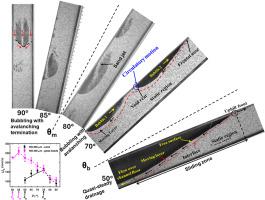倾斜闭顶准二维管道颗粒排水过程中的鼓泡现象
IF 4.3
2区 材料科学
Q2 ENGINEERING, CHEMICAL
引用次数: 0
摘要
研究了一个封闭的准二维矩形管道中重力驱动的颗粒排水。在水管相对于水平(θ)的大倾角范围内进行的实验表明,排水是通过“雪崩流”发生的。导管倾斜(θ >;θb),雪崩伴随着间隙空气的冒泡,这加快了排水的速度。然而,进一步增加导管向垂直方向倾斜(θ >;θm),当雪崩流停止而气泡继续时,排水速度减慢。流动可视化实验、图像分析、时空图和数字粒子图像测速(DPIV)测量提供了两种排水方式的详细定性描述和定量测量,即冒泡崩塌和雪崩流终止后的排水。在实验观察的基础上,提出了用于预测冒泡开始(θb)和雪崩流动结束(θm)临界管道倾角的现象模型,以及在θb≤θm和θm≤θ≤90°两种排水方式下气泡上升速度的现象模型。本文章由计算机程序翻译,如有差异,请以英文原文为准。

Bubbling phenomena during granular drainage from an inclined closed-top quasi-two-dimensional conduit
The study investigates gravity-driven granular drainage from a closed-top quasi-two-dimensional rectangular conduit. Experiments over a wide range of conduit inclination with respect to the horizontal (θ) reveal drainage to occur by “avalanche flow”. Beyond a conduit tilt (θ > θb), avalanching is accompanied by bubbling of the interstitial air, which hastens the rate of drainage. However, on further increase in conduit tilt towards the vertical (θ > θm), the rate of drainage slows down as avalanche flow ceases while bubbling continues. Flow visualization experiments followed by image analysis, spatio-temporal plots, and Digital Particle Image velocimetry (DPIV) measurements provide a detailed qualitative description and quantitative measurements in the two drainage regimes, viz, avalanching with bubbling and drainage after termination of avalanche flow. Based on experimental observations, phenomenological models are proposed for the prediction of critical conduit inclination for the inception of bubbling (θb), and termination of avalanche flow (θm), as well as the bubble rise velocity in the two drainage regimes, i.e. for θb≤ θ ≤θm and θm≤ θ ≤ 90°.
求助全文
通过发布文献求助,成功后即可免费获取论文全文。
去求助
来源期刊

Particuology
工程技术-材料科学:综合
CiteScore
6.70
自引率
2.90%
发文量
1730
审稿时长
32 days
期刊介绍:
The word ‘particuology’ was coined to parallel the discipline for the science and technology of particles.
Particuology is an interdisciplinary journal that publishes frontier research articles and critical reviews on the discovery, formulation and engineering of particulate materials, processes and systems. It especially welcomes contributions utilising advanced theoretical, modelling and measurement methods to enable the discovery and creation of new particulate materials, and the manufacturing of functional particulate-based products, such as sensors.
Papers are handled by Thematic Editors who oversee contributions from specific subject fields. These fields are classified into: Particle Synthesis and Modification; Particle Characterization and Measurement; Granular Systems and Bulk Solids Technology; Fluidization and Particle-Fluid Systems; Aerosols; and Applications of Particle Technology.
Key topics concerning the creation and processing of particulates include:
-Modelling and simulation of particle formation, collective behaviour of particles and systems for particle production over a broad spectrum of length scales
-Mining of experimental data for particle synthesis and surface properties to facilitate the creation of new materials and processes
-Particle design and preparation including controlled response and sensing functionalities in formation, delivery systems and biological systems, etc.
-Experimental and computational methods for visualization and analysis of particulate system.
These topics are broadly relevant to the production of materials, pharmaceuticals and food, and to the conversion of energy resources to fuels and protection of the environment.
 求助内容:
求助内容: 应助结果提醒方式:
应助结果提醒方式:


